CES 2006: Motherboards, Memory, Cooling, and a Few Surprises
by Wesley Fink & Jarred Walton on January 11, 2006 12:05 AM EST- Posted in
- Trade Shows
ECS
ECS has had a few interesting designs lately. First is their hybrid motherboard platform, the PF88 Extreme Hybrid, which allows you to convert to most other CPU/RAM platforms with the purchase of the appropriate daughtercard.
Presently supported are socket 754, 939, and 479. This product has apparently done quite well in Europe and Asia, but honestly, it doesn't impress us too much. By the time you spend $40 for the daughtercard and buy a new CPU and RAM, you've spent nearly as much as what you would pay for a new platform. We would prefer to keep the old system as a secondary unit or sell it off rather than worry about plugging in a new CPU, RAM, and daughtercard and leaving the existing components in place. Some of you might still find it worthy of consideration; we would say it's interesting, but we simply don't find it particularly useful.
Multi-GPU motherboards were a major theme at ECS, with some choices that we will have to test before recommending. Every possible official option is present or in development, along with a couple of unofficial configurations. ECS was one of the few places with an RD400X based system in development, and they actually have two: The PA1 MVP and the PA1 MVP Lite. The major difference is that the Lite model omits Gigabit Ethernet support and Firewire. Both are CrossFire platforms for Intel systems.
Even more unusual are the next two multi-GPU boards, both also for socket 775. The first is the PF22, a 955X-based motherboard with two X16 slots, one with only a 4X data connection, which is nevertheless listed as being CrossFire ready. The PF5 goes one step further, sporting a 945P chipset with the same X16 slot configuration, only with the claim that it is SLI hardware ready. Both are Extreme series boards, though whether they're truly geared towards the enthusiast or not remains to be seen. ECS does have a 975X board in development as well, with dual X16 slots (both with X8 data connections). Like Aopen, their 975X board will support the Core Duo ( Yonah) chips and socket 479 as opposed to 775. All three of these boards are unusual in some form or another, and we're curious to see how they actually work in practice.
What we would really like to see is for ATI and NVIDIA to both quit arguing about chipset superiority and simply allow their cards to run on any available platform. We've seen SLI on 975X and Xpress 200, and we've seen CrossFire on all the dual-X16 slot boards. While selling both the graphics cards and the motherboard chipset brings in more money, it's better to at least sell the graphics cards than to not sell anything at all.
In the more typical areas, ECS has a dual X16 SLI board in development for socket 939, the KN2 SLI. A standard dual X8 SLI board is also available, the KN1 SLI Lite. CrossFire isn't being neglected either for AMD systems, as both the RD480 and RD580 chipsets will be supported. However, the RD580 solution will be for socket M2 (now AM2) rather than socket 939, so it's still about six months out.
There are also plenty of boards that don't include support for multiple GPUs in the works or already shipping, but these weren't as attention-grabbing as the above options. Then again, there's something to be said for sticking with the guidelines of Intel, ATI, NVIDIA, and AMD. Going against the grain is a good way to stand out, but we can only hope that it will be standing out in a good way rather than serving as an example of what not to do. Time will tell whether ECS is being creative or merely insane.
ECS also had a Viiv ready solution on display, the P60. The unit is sleek and relatively attractive, and it includes a Mini-PCI TV tuner. It remains to be seen whether ECS will be selling the P60 directly or sourcing it for other interested parties. How many of these Viiv systems will reach market and how they'll perform is still up in the air, but clearly, Intel's current direction is to push that market. Hopefully, we'll get some units in-house for further testing in the not-too-distant future.
ECS has had a few interesting designs lately. First is their hybrid motherboard platform, the PF88 Extreme Hybrid, which allows you to convert to most other CPU/RAM platforms with the purchase of the appropriate daughtercard.

Presently supported are socket 754, 939, and 479. This product has apparently done quite well in Europe and Asia, but honestly, it doesn't impress us too much. By the time you spend $40 for the daughtercard and buy a new CPU and RAM, you've spent nearly as much as what you would pay for a new platform. We would prefer to keep the old system as a secondary unit or sell it off rather than worry about plugging in a new CPU, RAM, and daughtercard and leaving the existing components in place. Some of you might still find it worthy of consideration; we would say it's interesting, but we simply don't find it particularly useful.

Multi-GPU motherboards were a major theme at ECS, with some choices that we will have to test before recommending. Every possible official option is present or in development, along with a couple of unofficial configurations. ECS was one of the few places with an RD400X based system in development, and they actually have two: The PA1 MVP and the PA1 MVP Lite. The major difference is that the Lite model omits Gigabit Ethernet support and Firewire. Both are CrossFire platforms for Intel systems.
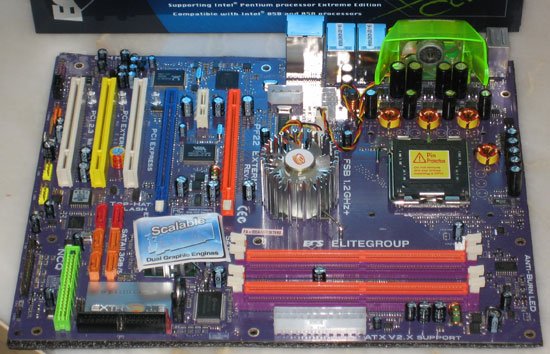
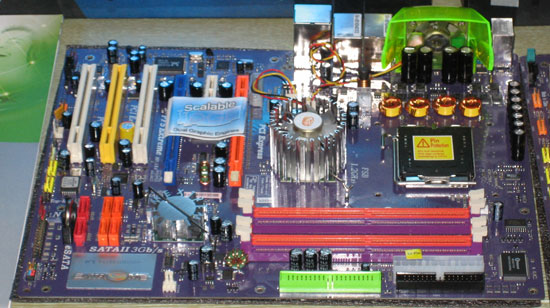
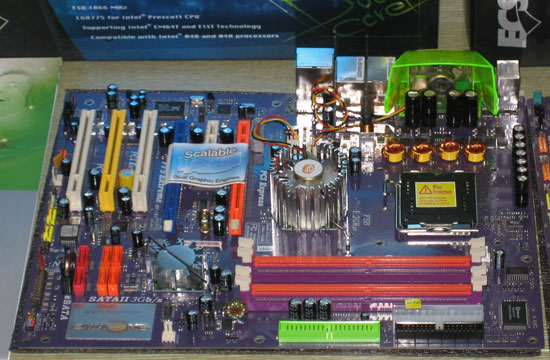
Even more unusual are the next two multi-GPU boards, both also for socket 775. The first is the PF22, a 955X-based motherboard with two X16 slots, one with only a 4X data connection, which is nevertheless listed as being CrossFire ready. The PF5 goes one step further, sporting a 945P chipset with the same X16 slot configuration, only with the claim that it is SLI hardware ready. Both are Extreme series boards, though whether they're truly geared towards the enthusiast or not remains to be seen. ECS does have a 975X board in development as well, with dual X16 slots (both with X8 data connections). Like Aopen, their 975X board will support the Core Duo ( Yonah) chips and socket 479 as opposed to 775. All three of these boards are unusual in some form or another, and we're curious to see how they actually work in practice.
What we would really like to see is for ATI and NVIDIA to both quit arguing about chipset superiority and simply allow their cards to run on any available platform. We've seen SLI on 975X and Xpress 200, and we've seen CrossFire on all the dual-X16 slot boards. While selling both the graphics cards and the motherboard chipset brings in more money, it's better to at least sell the graphics cards than to not sell anything at all.
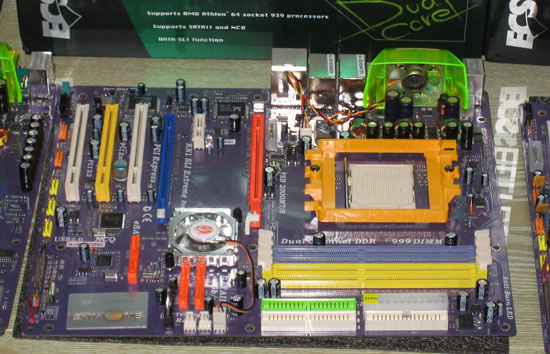
In the more typical areas, ECS has a dual X16 SLI board in development for socket 939, the KN2 SLI. A standard dual X8 SLI board is also available, the KN1 SLI Lite. CrossFire isn't being neglected either for AMD systems, as both the RD480 and RD580 chipsets will be supported. However, the RD580 solution will be for socket M2 (now AM2) rather than socket 939, so it's still about six months out.
There are also plenty of boards that don't include support for multiple GPUs in the works or already shipping, but these weren't as attention-grabbing as the above options. Then again, there's something to be said for sticking with the guidelines of Intel, ATI, NVIDIA, and AMD. Going against the grain is a good way to stand out, but we can only hope that it will be standing out in a good way rather than serving as an example of what not to do. Time will tell whether ECS is being creative or merely insane.
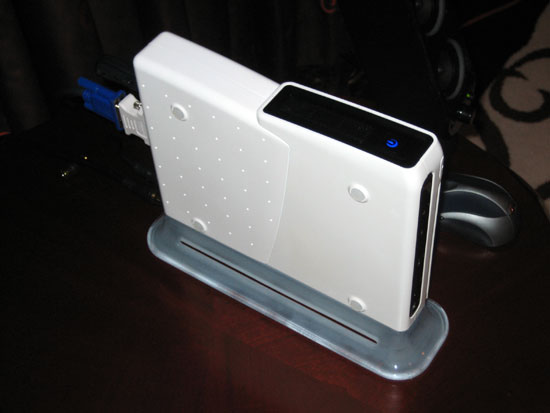
ECS also had a Viiv ready solution on display, the P60. The unit is sleek and relatively attractive, and it includes a Mini-PCI TV tuner. It remains to be seen whether ECS will be selling the P60 directly or sourcing it for other interested parties. How many of these Viiv systems will reach market and how they'll perform is still up in the air, but clearly, Intel's current direction is to push that market. Hopefully, we'll get some units in-house for further testing in the not-too-distant future.










36 Comments
View All Comments
Leinad - Saturday, March 4, 2006 - link
I see that the Corsair Nautilus500 is available, and at pretty much the expected price. I have searched around looking for any information on the Cryo-Z, and don't see any. Just curious if anyone in Anandland had any further information...I also wanted to second the request/suggestion of the addition of a cooling area to Anandtech.
yacoub - Thursday, January 12, 2006 - link
And the best thing about all the Asus boards pictured? EVERY ONE OF THEM IS PASSIVELY COOLED. About time. Dinky motherboard fans are the bane of many otherwise-quiet systems and they're often of such poor quality as to die within a few months and leave the user with a board that can overheat.Very nice work, Asus.
JarredWalton - Thursday, January 12, 2006 - link
Funny you should mention that. I have an ASUS K8N4-E Deluxe board that has been used less than 3 months. It has a dinky NB HSF, and guess what died this past week? So now I replaced that 30mm or whatever fan with a spare 60mm fan jury-rigged into the case, and it cools better and runs quieter. Small fans are garbage.SignalPST - Wednesday, January 11, 2006 - link
Sounds very promising. Hopefully, they'll fix the problems with the NB heatsink and 7800GTX 512MB getting in the way. When should we expect more details for this board?
FlyingShawn - Wednesday, January 11, 2006 - link
Quick correction on what looks like a typo on your DualCor coverage. The article states that the 1.5 Ghz processor runs XP Pro and the 400 Mhz runs XP Tablet. Actually, the 1.5 Ghz runs XP Tablet and the 400 Mhz runs Windows Mobile 5. So basically you have a full XP Tablet for when you need it and the instant-on benefits of a Mobile 5 PDA for when you need information like PIM data quickly.abakshi - Wednesday, January 11, 2006 - link
Yeah I was about to post that.That brings up another interesting issue though -- is data synchronized between the two sections (e.g. Outlook contacts/calendar/etc.), and do that mean you can run both parts at once and simply switch between the two (since they seemingly share only the user interface elements)?
Wesley Fink - Wednesday, January 11, 2006 - link
Yes, DualCor was demoing synchronized data between the 2 OS. I will correct the OS/processor statements in a few minutes.monsoon - Wednesday, January 11, 2006 - link
since we didn't get the new MAC MINI at Macworld, i'm eager to read your coming review of the AOpen PC Mini with CORE DUO insideHoudani - Wednesday, January 11, 2006 - link
Those Aopen boxes look stupendous on the outside. I'm eager to hear how their innards fare. All three of them there boxes are intriguing.wilburpan - Wednesday, January 11, 2006 - link
This is probably the wrong trade show for this, but was there any indication from CES as to whether BTX is increasing its penetration into the market?